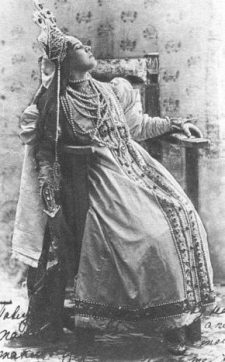Sunday, October 29, 1989
- 1989-1990 Season
- Symphony Orchestra
- Conductor: Harvey Felder
- Works Performed:
- Overture to The Tsar's Bride by Nikolai Rimsky-Korsakov
- Concerto for Flute and Harp, K. 299 by W. A. Mozart
- Symphony No. 5 in C Minor, Op. 67 by Ludwig van Beethoven
- Featured Artists: Deborah Fleisher
- Venue: Shriver Hall
- Time: 3:00 pm
Concert Details

Program
Symphonic Concert • Harvey Felder, Interim Music Director • Eric Townell, Assistant Conductor
Shriver Hall
Nikolai Rimsky-Korsakov: Overture to The Tsar’s Bride
W. A. Mozart: Concerto for Flute and Harp, K. 299
Steven Haaser, flute
Deborah Fleisher, harp
Ludwig van Beethoven: Symphony No. 5 in C Minor, Opus 67
Program Notes
Lois Rowell Karlsberger
Overture to The Tsar’s Bride
Nicolai Rimsky-Korsakov
The overture from Rimsky-Korsakov’s 1898 opera, The Tsar’s Bride, attests to his orchestral virtuosity and his affinity for dramatic subjects rooted in Russian history and folklore. A member of “The Mighty Five” of Russian nationalistic music, he was inspired by Glinka’s opera, A Life for the Tsar (1836). Characteristically, Rimsky-Korsakov’s operas display a wealth of color and lyricism, an extensive use of folk melodies, and a mastery of orchestral effects. Many of his operas move in a fantasy world of romance and legend. The Tsar’s Bride, however, is a tragedy, set during the reign of Ivan the Terrible.
Grigor loves Martha, fiancée of the aristocrat Lykov. Grigor asks a magician for a love potion; but the magician, compelled by Grigor’s former lover Liubacha, substitutes a slow but effective poison, which Grigor unwittingly gives Martha. Then, the Tsar announces that he will take Martha as his bride. She becomes Tsarina, but dies mysteriously. When Liubacha confesses, Grigor kills her, and he is arrested.
Concerto for Flute and Harp in C Major, K. 299
W. A. Mozart
Mozart composed this concerto in 1778, during his sojourn in Paris. Several months before, he had set out for Paris by way of Munich, Augsburg, and Mannheim, hoping to secure a major commission and a permanent position. Neither materialized, however, and soon after arriving in Paris, Mozart turned to influential persons for assistance in finding work. A long-time friend, Baron Grimm, introduced Mozart to the Duke of Guines, a favorite of the Parisian court and an accomplished flutist. It was for the Duke and his daughter, a harpist, that Mozart was commissioned to write the concerto on tonight’s program.
The result is a delightful and masterful example of French salon music, designed to please and charm the aristocratic Parisian society of the late eighteenth century. Scored for a small orchestra of oboes, horns, and strings, the concerto opens with a spirited Allegro that displays virtuoso capabilities of both instruments. Flute and harp are equally presented as soloists; they also appear in a soloist-accompanist relationship, the flute being occasionally paired in dialogue with violins. The graceful Andantino, according to Mozart’s biographer Enstein, is “decorative and sensuous but not lacking in deeper emotions.” Concluding the concerto is a rondo, Tempo di gavotta, which Einstein thought best exemplifies Mozart’s feeling for French taste. Lighthearted and cheerful, it abounds in appealing melodies, finishing, like the other two movements, with a cadenza and coda.
Symphony No. 5 in C minor, Op. 67
Ludwig von Beethoven
Writing on Beethoven’s instrumental music in 1813, novelist-musician E.T.A. Hoffman acclaimed the Fifth Symphony as “profound” and “magnificent”’ a “wonderful composition [that] leads the listener imperiously forward into the spirit world of the infinite!” For Berlioz, the Symphony mirrored “Beethoven’s innermost thoughts, his hidden grief, his pentup anger…his moments of bliss.” And for generations of listeners, Beethoven’s Fifth, in its energy and power, its sense of struggle and triumph, remains unsurpassed among his other symphonies as the summation of the composer’s personality. The music seems to project Beethoven’s adamant resolution: “I will grapple with Fate; it shall not overcome me.”
The Fifth Symphony, composed in 1807-08, broke new ground — first, in its thematic unity and organic wholeness. Paul Henry Lang calls it “the most convincing, the most miraculously concentrated symphonic structure in the whole musical literature.” Its motto theme of four notes, eloquently announced in the opening measures, dominates the first movement and recurs, in various forms, in all succeeding movements. Also unique for Beethoven’s symphonies to that time is the instrumentation of the Finale — woodwinds expanded by piccolo and contrabassoon, brasses augmented by trombones. Indeed, it is difficult to imagine the Finale without the splendor of the full brass choir, beginning with its dramatic fortissimo C-major chords that mark the climax of the crescendo from Scherzo to Finale. This inspired transition from C minor to C major, as if gates are flung open to reveal a new world of light, burst the boundaries of expression in the contemporary symphony. It made a powerful emotional appeal to the Romantic mind as a reflection of the ultimate breakthrough — tragedy ascending to triumph. While this spiritual concept is implied in numerous symphonic works since Beethoven, in none other has it so engaged the imagination. In our time, Beethoven’s Fifth remains a symbol of victory.
